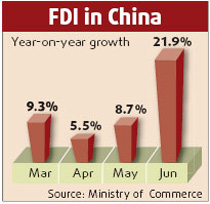The National Development and Reform Commission (NDRC), China's top economic planner, has announced on Tuesday that it will extend a price control policy to fertilizer, a move to protect the enthusiasm of farmers and the country's food security.
A senior official with NDRC made the announcement at a warning conference on price control of fertilizer.
He said that fertilizer makers run by the central government should not raise the ex-factory prices of urea while fertilizer manufacturers run by local governments should strictly control their ex-factory prices of urea, phosphate fertilizer as well as compound fertilizer. And other companies were required to submit a report for official approval when they intended to raise prices.
The interim price intervention covers the spring plowing period.
According to the government's policy, the price and market regulation agencies have the right to ask the enterprises to return the prices to normal or reduce the price rise range if the rise is considered unacceptably large.
The forecast for continuous price rises was prevailing before the government extends price intervention to fertilizer.
Statistics show the ex-factory prices of urea and compound fertilizer have surged to 1,725 yuan/ton (US$238.6/ton) and 2,600 yuan/ton(US$359.6/ton), respectively, both up more than 30 percent year-on-year.
Analysts attributed the price rises in fertilizer to international price interaction, cost increase and China's lack of phosphorus and potassium resources. The offshore price of urea in the Black Sea has reached US$400/ton, up 30 percent over the previous year. And the ex-factory price of monoammonium phosphate (MAP), which is the main raw material to produce fertilizer, has climbed to 3,100 yuan/ton from 1,800 yuan/ton early last year in China.
"Farmers are expected to suffer more from costs increase if the fertilizer prices continue to soar when the plowing season is approaching," Li Xianbin, deputy president and spokesman of China's Agricultural Means of Production Group, said earlier this month.
Xu Shaohua, a villager living in a town off the Dongting Lake in Central China's Hunan Province, was carefully calculating whether he could continue to live on farming.
"The price of urea grew by almost a half last year while the grain price rose a little. The rice has been sold at about 1.6 yuan/kilogram in recent years. The margins are really tight," said Xu.
Last year, numerous preferential policies have been taken by the Chinese government to increase the income and improve the livelihood of rural residents.
About 150 million rural students have been exempted from tuition fees in nine-year compulsory education and more than 200 million rural residents are entitled to an allowance for living, which is provided by the central and local governments.
But experts noted the government is to some extent in a dilemma - on the one hand it has to curb the prices of agricultural products to tackle inflation, on the other hand it must introduce measures to stimulate the farmers' enthusiasm.
Surges in prices of edible oil, meat, milk, eggs and liquefied petroleum lifted the consumer price index (CPI) to 4.6 percent in the first 11 months of 2007, and an 11-year high of 6.9 percent in November, well above the government's three-percent target.
Fertilizer is one of the most important means of production for farming, so the surge in the prices of fertilizer touches the most sensitive nerve of farmers.
"We hope that the fertilizer price will not continue to rise. Otherwise, it will offset all the income. It is good news that the government will introduce price controls," said Lu Guangchun, a farmer in the city of Changyi in East China's Shandong Province.
(Xinhua News Agency January 23, 2008)


